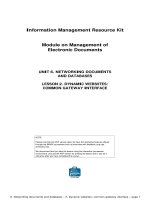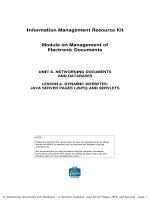UNIT 6. NETWORKING DOCUMENTS AND DATABASES LESSON 1. WEB STANDARDS AND STATIC WEBSITESNOTE doc
Bạn đang xem bản rút gọn của tài liệu. Xem và tải ngay bản đầy đủ của tài liệu tại đây (661.05 KB, 13 trang )
6. Networking documents and databases - Lesson 1. Web standards and static websites – page 1
Information Management Resource Kit
Module on Management of
Electronic Documents
UNIT 6. NETWORKING DOCUMENTS
AND DATABASES
LESSON 1. WEB STANDARDS
AND STATIC WEBSITES
© FAO, 2003
NOTE
Please note that this PDF version does not have the interactive features offered
through the IMARK courseware such as exercises with feedback, pop-ups,
animations etc.
We recommend that you take the lesson using the interactive courseware
environment, and use the PDF version for printing the lesson and to use as a
reference after you have completed the course.
6. Networking documents and databases - Lesson 1. Web standards and static websites – page 2
Objectives
At the end of this lesson, you will:
•haveacquiredknowledgeof the
communication standards on the Web, and
• be able to understand the capabilities and
limitations of a simple static website.
Introduction
How can you make resources available
to users on the Web?
The simplest way is to build a simple
website.
Before looking at how to do it, let’s
start with some basic concepts to
understand how you communicate
with your users on the Web.
We will build a small document
management website in order to
disseminate our documents with simple
bibliographic information.
6. Networking documents and databases - Lesson 1. Web standards and static websites – page 3
Uniform Resource Identifier
Web
Browser
Web
Server
Internet
HTML
HTML
HTML
The World Wide Web, or simply Web, is a
way of accessing information over the
Internet.
Together with e-mail, the Web is the most
popular way to disseminate information over
the Internet.
The Web is a client/server application:
• web-servers are computers that deliver
(serve up) web documents called web pages;
• to access a web page, users connect to the
web-server using a web browser (client),
such as Internet Explorer or Netscape.
On the Web, resources are identified by a scheme called URI (Uniform Resource Identifiers).
E.g.: .
A URI may include four parts:
SCHEME
Identifies the way in which the other parts of the URI syntax are to be used.
http:// www.fao.org /path/ask.cgi ? x=1&y=2&z=3
Click on each part to view the description
Uniform Resource Identifier
The most common form of a URI is a Uniform Resource Locator (URL) which identifies a
resource from its network location.
6. Networking documents and databases - Lesson 1. Web standards and static websites – page 4
www.fao.org
/path/ask.cgi
? x=1&y=2&z=3
AUTHORITY
A top hierarchical element for a naming authority, which for the
http scheme is the Internet domain name.
PATH
Data, specific to the authority, identifying the resource within the
scope of that scheme and authority (e.g. the file name in the
http scheme).
QUERY
A string of information to be interpreted by the resource.
Uniform Resource Identifier
For example, can you identify the parts of the following URI?
/>Click on your answers
http://
www.w3c.it
talks/XMLDays2002/overview.htm
SCHEME AUTHORITY PATH QUERY
Uniform Resource Identifier
6. Networking documents and databases - Lesson 1. Web standards and static websites – page 5
HTTP Protocol
The Web uses the HTTP protocol to transmit data.
HTTP is a simple request/response protocol: the
client sends an HTTP request message and the
server sends back an HTTP response.
For example, if you enter the URL
in your browser,
this sends a request to the server whose domain
name is fao.org. The server then fetches the page
named index.html and sends it to your browser.
HTTP is also a stateless protocol: the server can
handle a series of messages from a client, but it
responds to each one individually, one at a time,
without making any connection between them.
Web
Browser
Web
Server
Internet
HTML
HTML
HTML
HTTP request
HTTP response
HTTP Protocol
An HTTP message must have a precise structure.
Here is a typical HTTP request to retrieve the file index.html, with the relevant response:
HTTP REQUEST MESSAGE
1
DESCRIPTION
GET /path/index.html HTTP/1.1 Request line. It contains method (here GET
2
), name
of target resource, HTTP version.
Accept: text/html
User-agent: IE5
Header Fields (0 o +): sequence of name:value
pairs.
HTTP RESPONSE MESSAGE DESCRIPTION
HTTP/1.1 200 OK Response header
Mime_version: 1.0
Content_type: text/html
Content_length: 2000
Response header fields
<HTML>
<HEAD> <TITLE> … </TITLE> </HEAD>
<BODY> … </BODY>
</HTML>
Entity body (here it is the content of the file
index.html)
1
A request can also optionally contain an entity body.
2
GET is one of the 13 methods in HTTP/1.1, which support various manipulations of resources
on the server from the remote client.
PRINT TABLE
6. Networking documents and databases - Lesson 1. Web standards and static websites – page 6
So, a website is a site (location) on the World
Wide Web.
Each website contains a home page, which is the
first document users see when they enter the
site.
A site can also contain additional documents and
files. Let’s imagine you want to deliver a set of
documents and show simple bibliographic
information for each one, e.g.:
• Document title
• Publication date
• Author
• Language
•Format
• Description
You will build a simple static website.
Building a Simple Static Website
First, you have to design the site
map.
The graph on the right shows an
example of site map for five
documents, in several formats.
The first page (index.html) will
display the list of documents.
When selecting one from the list,
the document details for the
selected document appear.
From that second page, you can
view the document itself.
Now, let’s look at what the result
would be…
index.html
detailsD1.html
detailsD5.html
detailsD4.html
detailsD3.html
detailsD2.html
D1.pdf
D2.html
D3.xml
D4.pdf
D5.pdf
Building a Simple Static Website
6. Networking documents and databases - Lesson 1. Web standards and static websites – page 7
The first page would be similar to
the one on the left.
To access the first document, the
user would have to:
• select the document title, then
• select the format, “PDF”, to
bring up the document itself.
View Animation
Building a Simple Static Website
The first step to achieve your goal is to build the “Document List” page (index.html).
This is a fragment of how the HTML page should look:
The <a href=“detailsD1.html”>
specifies a hypertext link to another
HTML document.
The “detailsD1.html” page contains the
document information for the “XML
and Database Mapping in .NET”
document.
Each document has its own
“detailsD#.html” page.
Building a Simple Static Website
View the entire HTML page
…
<h1 align="center">Document List</h1>
<table cellpadding="10" cellspacing="0" border="1"
align="center">
<tr>
<th align="left">Document Title</th>
<th align="left">Date</th>
</tr>
<tr>
<td><a href="detailsD1.html">XML and Database
Mapping in .NET</a></td>
…
6. Networking documents and databases - Lesson 1. Web standards and static websites – page 8
On the “detailsD#.html” pages
there is a hypertext link to the
PDF.
Selecting “PDF” on the page will
bring up the PDF in the browser.
Building a Simple Static Website
Now, you have to build the “detailsD1.html” page.
This is a fragment of how this page should look:
…
<tr>
<th align="left">Language</th>
<td>EN</td>
</tr>
<tr>
<th align="left">Format</th>
<td><a href="D1.pdf">PDF</a></td>
</tr>
…
View the entire HTML page
Building a Simple Static Website
Imagine you want to add a sixth document, entitled: “Introduction to HTML”, to the list.
Where would you have to enter the following codes?
<td><a href="D6.pdf">PDF</a></td>
<td><a href="detailsD6.html">
Introduction to HTML </a></td>
detailsD6.html
index.html
Click on each option and drag it to the relevant box.
6. Networking documents and databases - Lesson 1. Web standards and static websites – page 9
Limitations of Simple Static Website
To add a new document to the list, you would
have to:
• create a new “detailsD#.html” page with
the document details (e.g. “detailsD6.html”),
and
• modify the index.html (Document List
Page) by adding the new document’s title, date
and hypertext link to its detailsD#.html page.
This means that you must edit the index.html
whenever you add a new document.
This is only one of the limitations of a simple
static website…
How can I add a sixth document to my
list?
Limitations of Simple Static Website
A simple static website has other limitations as a
client/server application:
• Information is repeated in the home page
(index.html) and each of the details pages, so you
need to be careful when we update the pages to
make sure the information is consistent (not to
mention the extra effort involved in typing out the
same information twice).
• We can’t sort the list of documents, since it’s a
static list, fixed in index.html.
• What happens if the list becomes very long?
You can’t have a sequence of pages with a limited
number of documents listed on each one.
• Users can’t search for documents.
6. Networking documents and databases - Lesson 1. Web standards and static websites – page 10
Limitations of Simple Static website
There’s another general limitation
of static websites, which comes
about because we don't have
access to programming logic: we
can’t have a user ‘session’ which
remembers what the user has
done so far and adjusts the
behaviour of the applications as a
result.
Limitations of Simple Static website
Some of the limitations of static websites have
been overcome by dynamic websites.
A dynamic website allows users to interact with
program logic on the web-server.
The information or content for the web pages is
stored in the database and is revealed when
requested through a web browser by the user.
There are many technologies for producing
dynamic sites, including CGI (Common
Gateway Interface), Java technologies (servlets
and Java Server Pages), ASP (Application
Server Pages), PHP (Personal Home Page).
6. Networking documents and databases - Lesson 1. Web standards and static websites – page 11
Summary
• TCP/IP is the most popular of all networking standards: it identifies the
devices on a network and ensures that the data are correctly transmitted.
• If we want to link more networks together, then we can use a router, a
device which knows about the IP numbers on each network.
• Resources are identified on the Web by a scheme called URI (Uniform
Resource Identifier).
• In a simple static website, information is repeated both in the home
page (index.html) and each of the details pages, so we need to be careful
when we update the pages.
• Moreover, we can’t have a user ‘session’ which remembers what the
user has done so far and adjusts the behaviour of the applications as a
result.
Exercises
The following three exercises will allow you to test your understanding of the concepts described
until now.
Good luck!
6. Networking documents and databases - Lesson 1. Web standards and static websites – page 12
Exercise 1
Can you associate the following elements to their definitions?
TCP
IP number
A number that identifies the devices
connected to the network.
A protocol that ensures the correctness of
the information transmission.
A device that knows the IP numbers on
different connected networks.
Router
Click on each option and drag it to the relevant box.
Exercise 2
In which kind of HTTP message are included the following parts?
GET /path/index.html HTTP/1.1
<HTML>
<HEAD> <TITLE> … </TITLE> </HEAD>
<BODY> … </BODY>
</HTML>
HTTP request
HTTP response
Click each option, drag it and drop it in the corresponding box.
When you have finished, click on the confirm button.
6. Networking documents and databases - Lesson 1. Web standards and static websites – page 13
Exercise 3
Which of the following is a limitation of a simple static website?
Click on your answer
It can contain only a limited number of resources.
It can’t contain multimedia resources.
Updating its content can take a lot of time.
If you want to know more
The technology of the Internet has been developed by the Internet
Engineering Task Force (IETF) which provide a useful starting point
for research (www.ietf.org)
From its early days, the Internet has been ‘managed’ by the Internet
Society (www.isoc.org)
The World Wide Web Consortium sets information standards for the
Web (W3C – www.w3.org)
The official source of information on how to address resources on the
Web (www.w3.org/Addressing)
Open source web-servers are available from the W3C (Jigsaw -
www.w3.org/Jigsaw) and the Apache Software Foundation
(www.apache.org).
Spainhour, S. & Eckstein, R. 2003. Webmaster in a Nutshell.
O'Reilly UK; ISBN: 0596003579








